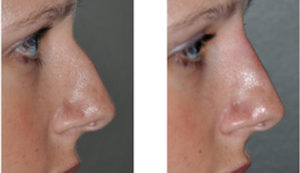Rhinoplasty is a well known reshaping operation of the nose with a long history and a large number of techniques to accomplish these changes. Despite the many rhinoplasty techniques and a lot of experience in performing them, there is always the risk that some irregularity or asymmetry will develop after surgery. While many of these post-rhinoplasty asymmetries and irregularities may be ideally treated surgically with cartilage adjustments or grafting, this presents the need for a return trip to the operating room, anesthesia and additional expenses.

In the May 2013 issue of the European Journal of Plastic Surgery, an article was published entitled ‘Use of Hyaluronic Acid in the Correction of Contour Asymmetries Following Rhinoplasty’. Over a 6 month period, a total of 12 patients who had contour problems after rhinoplasty were treated. A hyaluronic acid filler was injected from subcutaneous to subperiosteal/subperichondrial. The results were evaluated on a 1 to 10 satisfaction scale for up to one year after the injections. No side effects were reported. All patients were satisfied with the filling procedure even though they were aware of the non-permanent nature of the procedure.
It is no surprise that the use of a hyaluronic filler in the nose meet with a high satisfaction rate and, in this report, no complications. They key is to use low volumes and spot application of the filler. The riskest area of injection into the nose is the tip and large volumes should be avoided. (although they would rarely be needed anyway)
In my experience, most of the deformities after rhinoplasty are relatively small and discrete. And unlike when placed in the lips or nasolabial folds, the lack of any motion or facial expression across the nose allows them to last beyond what one would expect in other more typical facial application areas.
Dr. Barry Eppley
Indianapolis, Indiana


